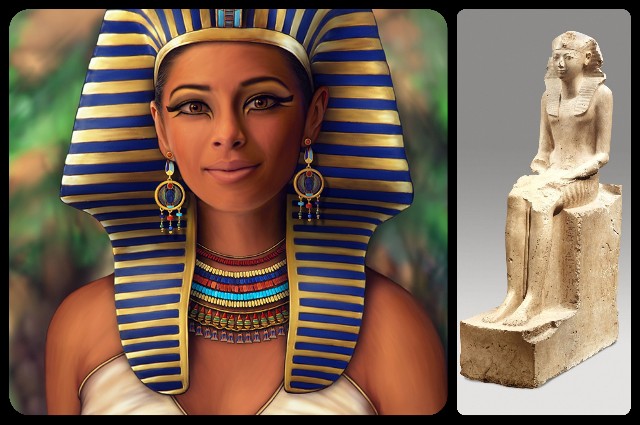Hatshepsut, a female pharaoh during the New Kingdom in Egypt, held the position of the most powerful person in the Bronze Age world for over 20 years. This period marked the beginning of many significant developments, including writing, centralised states, organised warfare, irrigation projects in the desert, and the emergence of emperors, warlords, and chariots. Despite these advancements, women in positions of power were not common during this era.
Queen Hatshepsut, meaning “Foremost of Noble Women,” was a notable exception. She ruled the wealthiest Kingdom ever seen as a fully-fledged Pharaoh. However, upon her death, her legacy was intentionally erased, and today, few can even pronounce her name. But who was Hatshepsut, and why is she considered one of Egypt’s greatest Pharaohs? Let’s find out.
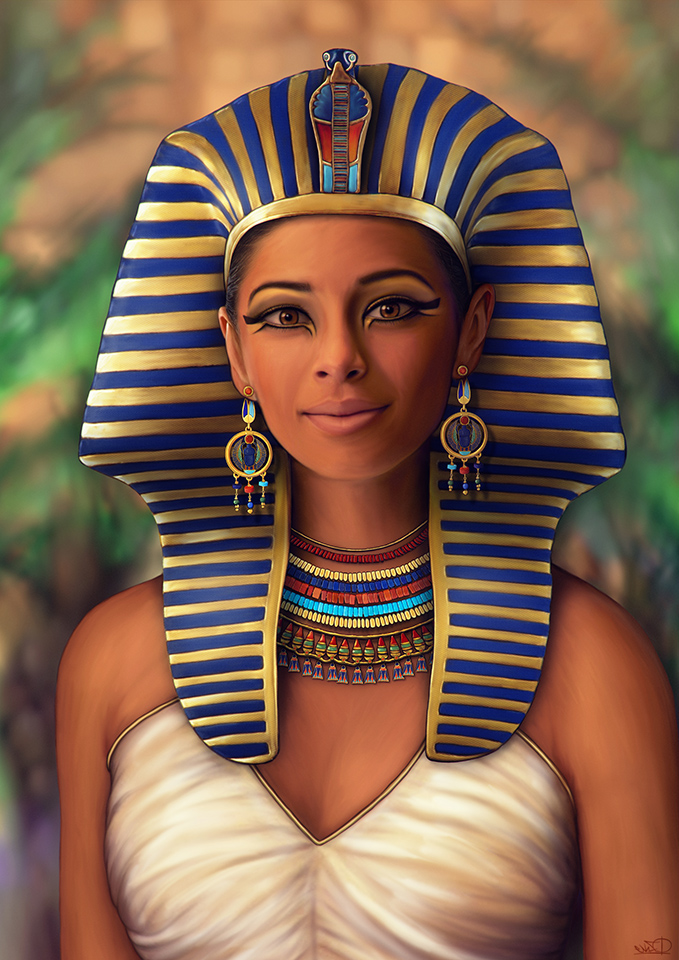
When Pharaoh Thutmose I died, he had no male heir to succeed him. Therefore, a middle-aged nobleman named Thutmose, who was highly respected in Thebes, took over the throne in around 1506 B.C. As a result of Thutmose I’s prosperous reign, Egypt experienced an unprecedented era of growth and success, with the borders expanding and gold pouring in. During this time, Thutmose I and his wife Ahmose had a daughter named Hatshepsut.
Although having a son would have been preferred in Egyptian society, Thutmose I had plans for Hatshepsut. From a young age, she was trained to become the next god’s Wife of Amun, the patron god of Thebes and a creator god. The Amun Priesthood was a powerful institution with immense wealth, lands, and temples. The God’s Wife was the second-highest-ranking priestess in the priesthood, responsible for performing the correct spiritual offerings and providing the “activity” necessary for the god’s statue to function properly. As god’s Wife, Hatshepsut also owned vast estates and lands.
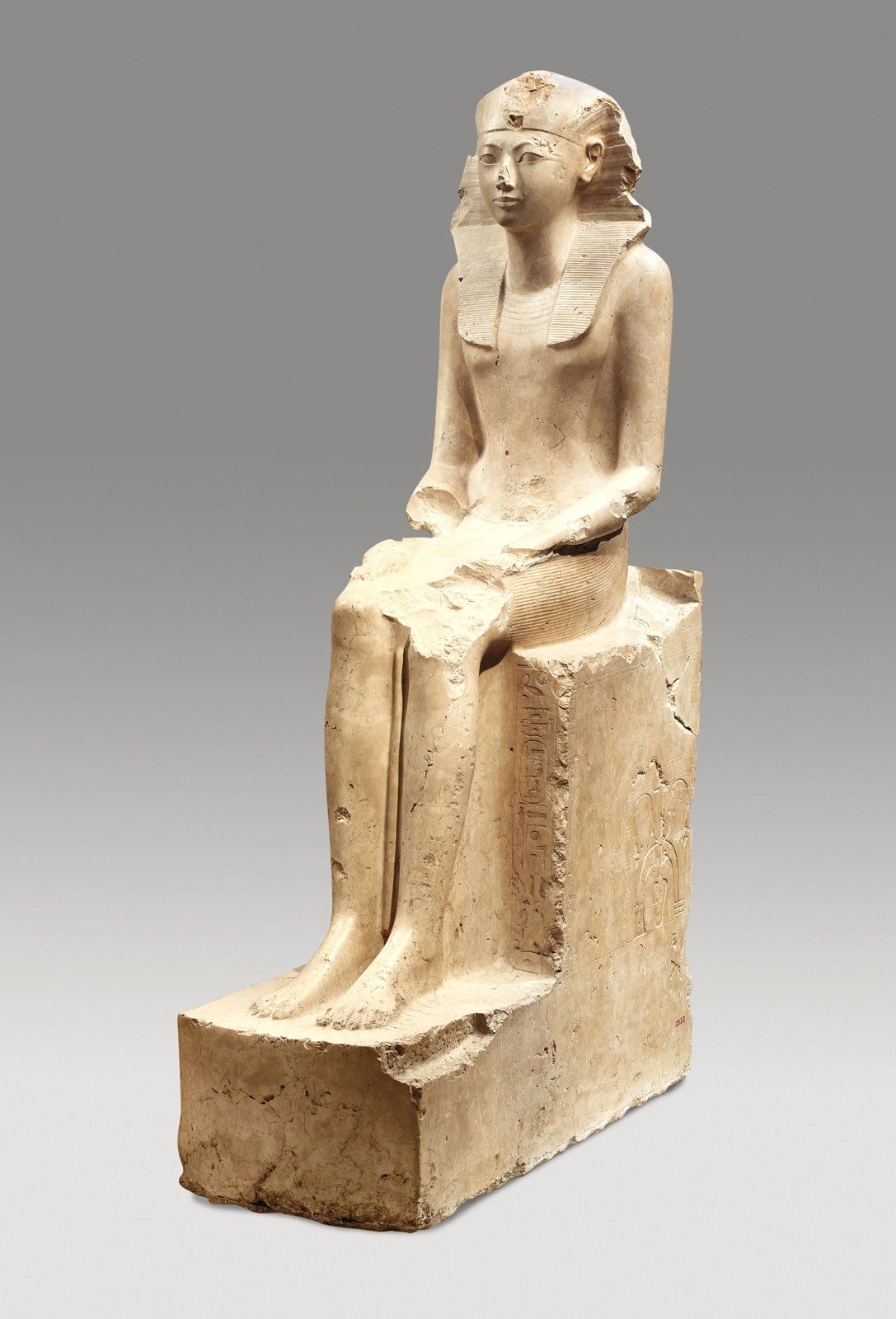
Consequently, Hatshepsut was educated by top political, religious, and economic mentors in Egypt, and at a very young age, likely before 10, she became god’s Wife. Thutmose aimed to install someone devoted to him in the influential position. Hatshepsut likely picked up strategies for winning wars and managing building projects that served as both job programs and propaganda by attending important events with Thutmose. She grew up as the most prominent priestess in the realm.
All that remained was for Hatshepsut to marry her full brother and become the King’s Great Wife, which was bizarre and quite awkward, but was done to produce the most legitimate heir possible in the eyes of the Egyptians.
At the tender age of 12, Hatshepsut faced a tragic turn of events as her two full brothers and heirs to the throne passed away. She was left as the only pure royal child. Her half-brother, also named Thutmose, I became the new heir to the throne, but he was nothing like his strong father.
Thutmose II was plagued with physical ailments, such as lesions, an enlarged heart, and shortness of breath. Despite his health issues, the court relied on him to continue the Thutmosid line to secure their own jobs and livelihoods. However, another tragedy struck as Thutmose I passed away, leaving behind a young boy who was too weak and inexperienced to hold real power.
Hatshepsut, now around 13 years old, became the King’s Great Wife to her half-brother, Thutmose II.
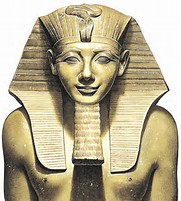
As a teenager, Hatshepsut found herself holding the reins of power in Egypt, with the entire kingdom depending on her ability to produce a male heir. Fortunately, she was an important religious figure and had already gained experience running her own estates, which gave her the necessary skills to dominate the relationship with her husband, Thutmose II, and advise him on how to rule his kingdom.
Hatshepsut gave birth to a princess, Neferure, and the possibility of not having a male heir threatened to repeat the cycle that had brought Thutmose I to power. This uncertainty would have created chaos in Egypt, especially for the unpopular brother-sister couple.
After just three years on the throne, Thutmose II passed away when Hatshepsut was about sixteen years old. Although Thutmose II had managed to father some male children with women from his harem, these offspring were not considered pure enough to succeed him. Nonetheless, in desperate times, these non-incestuous babies would have to do.
Thus, faced with the challenge of a baby prince as the only viable heir to the throne, Hatshepsut took charge. She realized that the best way to assure the people of Egypt was to have Amun, the chief deity, choose the next Pharaoh. In a public ceremony, a statue of Amun was brought in, and the baby princes were lined up in front of it. Amazingly, the statue selected another Thutmose – son of Isis – who became Thutmose III.
Thanks to Hatshepsut’s bold actions, Thutmose III was now on the throne. As he was just a child, Hatshepsut acted as regent, despite being his aunt and stepmother. This was an unusual move since it was usually the mother who acted as regent. However, Hatshepsut’s confidence and competence won over the priests, generals, and bureaucracy, who trusted her with the responsibility.
Hatshepsut began to accumulate power slowly and strategically. She took control of palaces, temples, granaries, and the army, and connected every aspect of Egyptian life back to her. She also rewarded the Amun priesthood, who now owed her their undying allegiance. This helped solidify Hatshepsut’s position as the real power behind the throne and paved the way for her to become one of the most successful pharaohs in Egyptian history.
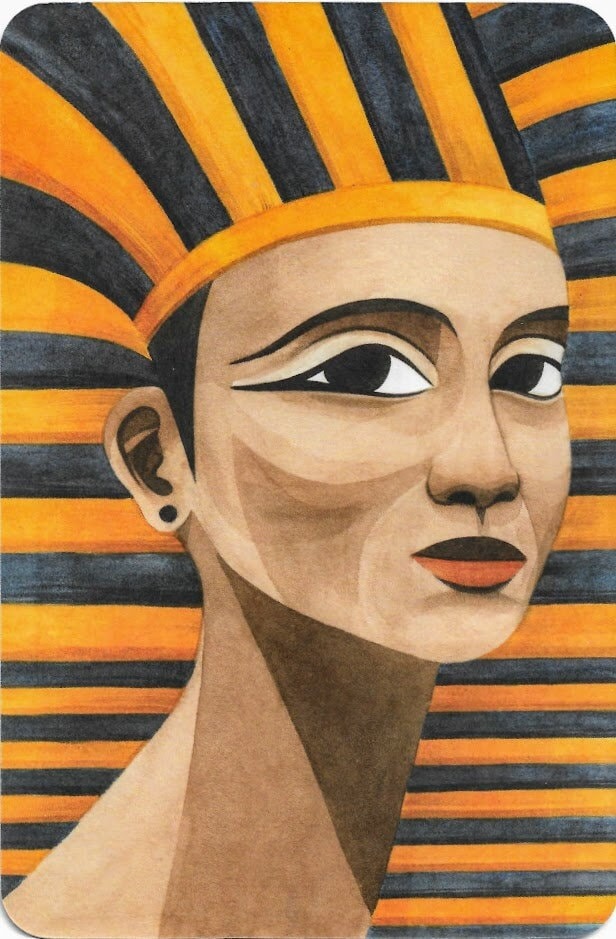
Hatshepsut’s hold on power grew stronger as she utilized a combination of bribery and intimidation to gain the support of local governors, efficient collection of taxes, and the construction of new temples. Her royal heralds were sent across the country and beyond to speak on her behalf and reward loyal supporters, while she staffed temples with full-time professional priests who were invested in her reign.
Through her gradual accumulation of power, Hatshepsut had amassed a formidable alliance of religious, political, and military supporters. She built a broad base of support from every possible corner of her realm, making it the obvious choice for her subjects to support her. Unlike other rulers, she never resorted to violence or tried to ally with powerful generals, as her power was already firmly established.
As her power grew, Hatshepsut prepared to relinquish her position as god’s Wife of Amun and groomed her daughter, Neferure, to take over the role.
Hatshepsut understood that Thutmose III needed more time to establish his rule, even though being god’s Wife was not a lifetime position. Thus, early in his reign, she began carving important messages into obelisks, temples, and palaces across Egypt. These inscriptions depicted her performing tasks that a king would normally do, such as speaking to the gods, making offerings, issuing commands, and wearing the gown of a queen on her body but the crown of a king upon her head.
These were all traditional masculine tasks that were performed by male Pharaohs. Yet Hatshepsut, a woman, was claiming these duties even before she was officially king. She understood the way people in Egypt thought, and so she employed this strategy to solidify her power and to establish herself as a legitimate ruler in the eyes of the people.
Hatshepsut’s transformation from queen to regent to Pharaoh was a long and calculated process. Her image became increasingly kingship-like as she took on traditional masculine duties and claimed Amun’s endorsement. Despite the difficulties of having a woman in power in ancient Egypt, Hatshepsut was finally crowned king around the seventh year of Thutmose III’s reign. However, Hatshepsut had already been running Egypt’s day-to-day business for years, building temples, collecting taxes, and commanding governors, all while crushing rebellions.
Hatshepsut’s rise to kingship is a remarkable example of merit triumphing over ambition. By doing the duties of a king, Hatshepsut became a king in the eyes of her people. To announce her coronation, she erected two gigantic obelisks at Karnak Temple, which were at the time the tallest in the world.
In the ancient world, the creation of an obelisk was considered a divine achievement, reserved only for someone chosen by the gods. Hatshepsut constructed these structures with great speed, and one of them still stands today, while the other, unfinished, remains buried in the ground.
She erected more pairs of red granite obelisks in Karnak Temple than any other known Egyptian monarch. All of these obelisks were partly covered with electrum so that, when the sun struck them at the right angle, they would gleam and appear to harness the energy of the sun itself.
The self-assured Pharaoh took charge and initiated a flurry of construction activity. Numerous skilled craftsmen were employed to work on grand temple projects throughout Egypt. The quality of their work was unparalleled and had not been witnessed in centuries.
Magnificent temples were chiseled out of solid rock, colossal pylons towered high, and obelisks stood tall. However, the most innovative construction was her mortuary temple located at Deir el-Bahri, which Hatshepsut named Djeser-djeseru, signifying Holy of Holies.
The temple was an impressive masterpiece with vast colonnades. It boasted spacious open areas across three different levels, interconnected by ramps. The terraces, which were once adorned with gardens filled with exotic plants and fragrant incense trees, seamlessly blended into the mountain behind it. Despite being over 3000 years old, the temple’s design is remarkably contemporary.
Egypt was primarily constructed using mud-brick buildings when Hatshepsut ascended to power, but under her rule, the country was rebuilt with stone structures. Meanwhile, Thutmose III grew up to become a strong and healthy warrior.
Hatshepsut sent Thutmose III on a journey across Egypt to develop his skills as a great general and establish connections with prominent figures from all over the Mediterranean. However, in Egypt, a woman could outrank a boy but not a man. This posed a challenge to Hatshepsut if she wanted to maintain her and Thutmose’s legitimate rule.
Initially, Hatshepsut was depicted as a woman wearing a dress and the headgear of a king in her earliest images. However, this representation was no longer acceptable. Consequently, she gradually shifted all her depictions to that of a man’s body, adapting to the times and culture. Despite this transformation, Hatshepsut still utilized “she” and “her” in her writings, indicating her unwillingness to relinquish her feminine identity entirely.
To complete her and Thutmose III’s transformation, Hatshepsut organized a Sed festival, a celebration of a Pharaoh’s 30th year in power, even though it was only her 15th year. This marked yet another departure from tradition.
After the Sed festival, Hatshepsut’s temple images no longer depicted her as a woman. By this time, her co-king Thutmose III had reached the age of roughly 17, and the Sed festival served as a formal announcement of his coming to power. With the borders expanding and wealth pouring in, Hatshepsut had secured the succession and could prepare for her final resting place in the Valley of the Kings.
After a remarkable reign of 21 years as the leader of the world’s most powerful Kingdom, Hatshepsut passed away around the age of 50 in 1458 B.C. Recent research indicates that she died of bone cancer, likely a result of her age and lifestyle.
In 2018, German researchers discovered that a flask of lotion found in Hatshepsut’s tomb contained a carcinogenic substance, similar to that found in cigarette smoke. It was believed that the Pharaoh used it to treat skin conditions like eczema.
Although Hatshepsut died as a king and was buried in the Valley of the Kings, something changed. Her successor, Thutmose III, may have attempted to erase her legacy, leading to a period of historical obscurity until her rediscovery in modern times.
Despite Hatshepsut’s efforts to secure Thutmose III’s rule, her legacy was eventually erased from Egypt. Twenty-five years after her death, Thutmose III ordered her image to be hacked off of every temple in the country, a systematic campaign to destroy her memory. Chisels and hammers rang out across the land, erasing the legacy of one of Egypt’s greatest rulers. Despite the volume of her monuments, the work to replace her was shoddy, with some of her images simply being replaced with offering tables. Most of the time, there were simply giant Hatshepsut-shaped holes left scarring the walls of the temples she built.
However, this was not an act of hatred on Thutmose’s part. Instead, he waited until the end of his reign to erase Hatshepsut’s legacy, only doing so when he needed to establish legitimacy for his own son. He had to prove that the crown had passed from Thutmose I to II, then to III, and now it would go on to his son. Aberrations had to be removed. Once his son was on the throne, the destruction stopped.
Possibly motivated by a desire to secure the male line of succession in the Thutmosid Dynasty, Thutmose III sought to erase Hatshepsut from history as a powerful female ruler. As a result, her legacy was largely forgotten until the decipherment of hieroglyphics in 1822. Despite this effort to erase her memory, Hatshepsut’s true legacy lived on through her architectural innovations and the wealth she brought to her people.
In 1903, Howard Carter discovered one of three sarcophagi prepared for Hatshepsut, but it was empty. Her mummy was later discovered in 2007 and is now housed in the Egyptian Museum in Cairo. A statue of Hatshepsut at the New York City Metropolitan Museum also survived the destruction of her stepson’s reign.
Hatshepsut’s greatest achievement was creating the first truly successful female kingship, breaking with tradition without bloodshed and keeping her family and country from collapsing. Her success was rewarded with a short memory, but her light still shines today through time and knowledge.
